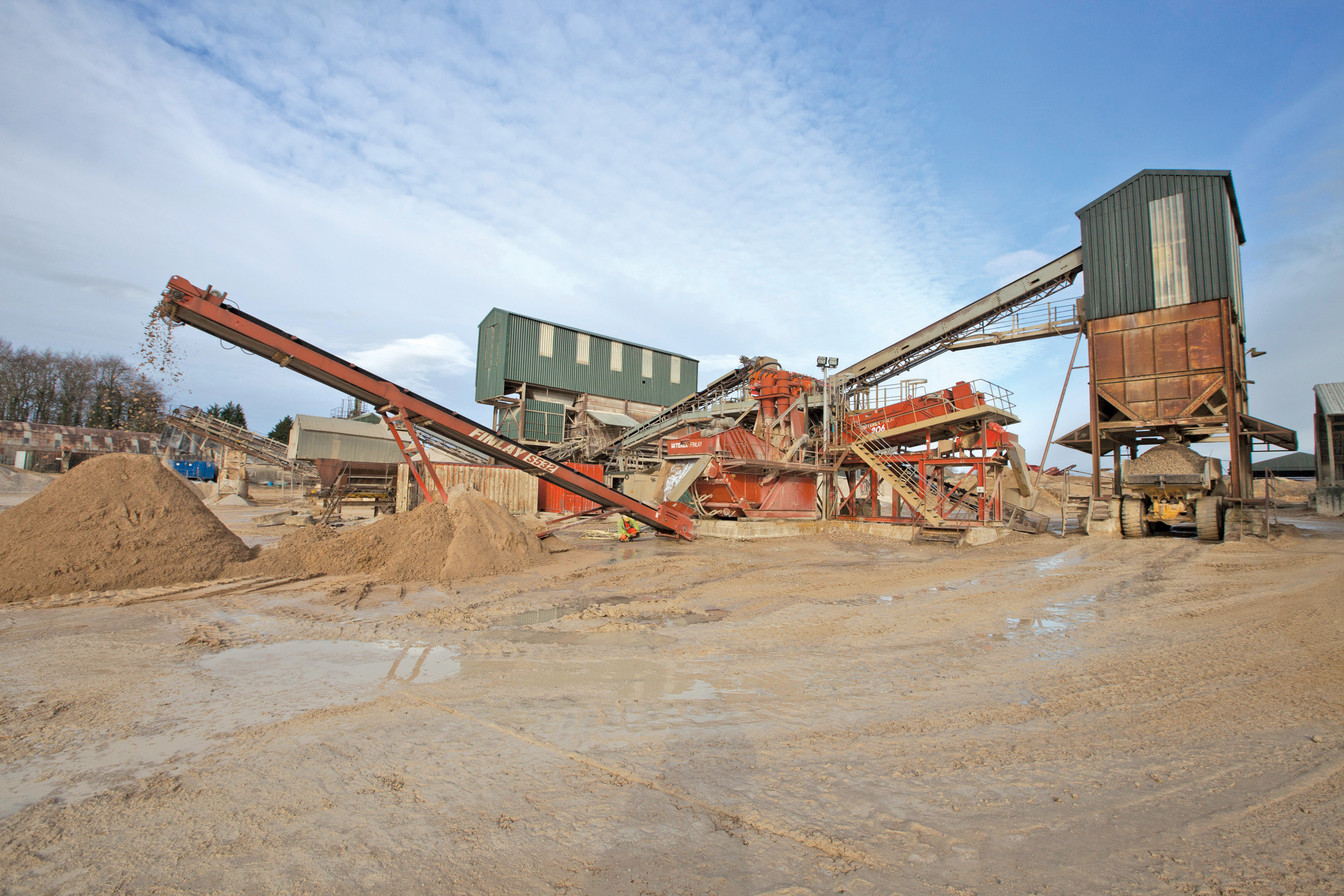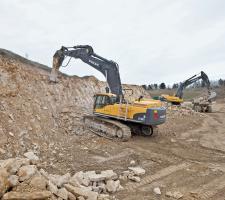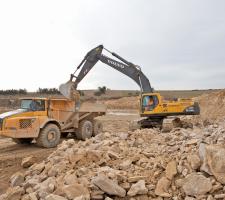
After a prolonged period of extended use for its fleet of plant and equipment, Huntsmans Quarry has started to reinvest in its machinery fleet as new markets and opportunities evolve for its Cotswold limestone products. Geoff Ashcroft reports
If money – and indeed customers - were in plentiful supply, David Glenn would choose to renew most of his plant at
But the slump in demand for aggregates has seen Huntsmans’ output reduced from its peak of over 300,000tonnes pre-2008 to 200,000tonnes/year. Fortunately, the industry is slowly turning a corner, and while outputs will struggle to get anywhere near that of the halcyon days, there is a slow and steady upward trend starting to materialise.
As a result, the company based near Stow-on-the-Wold, County Gloucestershire, south-west England, has been pushed towards developing complementary elements to its aggregates production business while making frontline kit last a little while longer.
The company has made a few changes to its fleet, but tough times have resulted in a steadfast approach to getting the best value from kit and that means they have to clock up the hours.
However the extended replacement policy has meant a keener focus on servicing and preventative maintenance for a fleet that includes around 35 items of mobile plant. And this has also stretched workshop facilities given that the company also runs a fleet of 15 trucks, with mixer, tipper and demount bodies.
Until recently, Huntsmans has relied on a fleet of three
“The A25s are wearing their hours very well,” says Huntsmans managing director David Glenn. “Three of them are Cs and date back to 1995-96, and their hour meters are showing over 30,000 hours, while our 1992-model A25B has covered just over 22,210 hours. Though they are like broom head and broom handle: you keep rebuilding engines and transmissions to keep the rest of the truck in good working condition.”
The A25s were joined by an A40D, bought from Chepstow Plant at the end of 2008, just as the market was heading for a slump.
“We probably shouldn’t have bought the A40D at the time, but with just 2,800 hours on its clock at the time and the need to move more overburden on the longer runs through the quarry, the bigger truck has helped us to move material much more efficiently,” says Glenn.
At that time, he sidelined two of the A25s from frontline duties, giving the 40tonner its head. And having been impressed with its performance and efficiency, the company added a second A40D at the end of 2012.
The 2007, 10,000-hour example has allowed two of the A25s to be offered for sale, and the remaining two will be kept for rehandling duties around the processing plant.
“Our A25s are worth next to nothing, though if I can’t get the price I need for them, I will just keep them going for light duties,” adds Glenn.
“They have a value to us in parts and they will continue to be used until they become unserviceable.”
Jurassic stone
Taynton limestone has been extracted by Huntsmans Quarries since 1936. The Jurassic stone has a reputation for good frost resistance and in its natural Cotswold honey and buff colours, is indicative of the region from where it comes.
As a high quality aggregate, it continues to find its way into the construction and building sectors as hand-dressed walling stone, roofing slate and decorative stones in addition to traditionally processed sands, gravels and hardcore materials that are produced en-route to finding the highly desirable Cotswold stone products.
Current production levels at the quarry are creeping up to 250,000tonnes/year, producing a variety of products based on the site’s Jurassic limestone. The company also manufactures 5-600m of concrete blocks on a daily basis, and a quantity of Atlas reconstituted stone: the latter uses 95% of Huntsmans’ own products and is based on dusts.
Huntsmans has recently added a recycling plant complete with a log wash, separator, dewatering plant and sand washer. The installation creates 6mm, 10mm, 20mm and 40mm oversize materials, plus sharp and fine sands, to be recovered.
Two mobile crushers are operated here: a Parker 1100/50 tracked jaw crusher and a
“In just two years, we’ve developed the process to recover around 65% of the 70,000tonnes we take in annually,” he says.
Glenn and his team have gone to great lengths to ensure the whole operation is geared around serving local markets, including that of local builders and contractors.
“We’re a one-stop shop for many construction businesses,” he says. “When they come to bring in their waste, they also come to buy our aggregates.
“Our recycling target is 85%, and everything we produce from the recycling plant is complementary to the Cotswold materials that we extract and process from the quarry workings. Even our Atlas walling takes 10% of our recycled fine sands and our blocks take all our recycled 6mm stone and a percentage of recycled sand.”
This local focus runs right through the quarry. And an on-site ready-mix plant delivers 90% of its concrete within 25 miles (40km) of the quarry, while 100% goes no further than 50 miles (80km).
“We’re a Cotswold quarry producing local stone for local markets,” he says. “And if we had to rely purely on crusher runs over the last few years, I’m not sure that we would be in quite the position to start reinvesting in equipment.”
The company is reliant on a predominantly Volvo fleet, though a
Huntsmans preference for Volvo equipment has been rewarded, rather than tested to extremes. A couple of “out of warranty engine failures” and the way these issues have been handled has put the Swedish maker at the top of Glenn’s - and quarry manager Phil Stayt’s - machinery supplier list.
“Our EC460B suffered an engine failure at 8,600 hours and as it was around 4-5 years old at the time, there was no warranty remaining,” explains Phil Stayt. “The engine started to misfire and it turned out to be a cam failure, which led to an engine replacement. Volvo was very accommodating in getting us up and running.”
That EC460B is now ten years old and is wearing its 20,000 hours extremely well: proof if it were needed, that Hunstmans knows how to make equipment last, and how to get the best from its purchases.
“Yes, Volvo kit is expensive to buy, but we balance off the cost against machine longevity, and the hours we now have on our machines seems to indicate our decisions, so far, have been wise ones,” he adds.
“Usually, we can see in excess of 16,000 hours on the clock before we need to reach for the engine rebuild kits.”
The EC460B is one of two primary machines working at the face, though it’s not rated by Phil Stayt as a digging tool.
“It is more of a loading tool and lacks bite for face work,” he says. “Our ten-year-old EC360B will run rings around it, and that’s done 15,750 hours. It’s a much faster, agile and more aggressive excavator.
“And it makes me think we don’t need as big a machine as the EC460B on the face: I believe a smaller machine could do the same work and deliver greater productivity on less fuel.”
The company did look at replacing the EC460B during 2010, but backed away when the final costs were taken into consideration alongside a reduced demand for aggregates. If all goes to plan, the 46tonner should be replaced later this year, while the 36tonner is up for eviction in 2014.
Using excavators on the face, rather than drilling and blasting, allows Huntsmans to recover much more material as the company works its way through the Cotswold landscape, carefully harvesting stone from seams.
The task of extracting the lucrative Cotswold stone at Naunton falls squarely at the feet of two hydraulic excavators: a 70tonne Volvo EC700C, which gets access to an
The 70tonner is supported by a 45tonne Volvo EC460B, which loads the loosened materials into its two A40Ds.
Too much damage and fragmentation from hammering can also render the stone useless as a high value roofing slate or walling stone: where high quality hand-dressed Stonesfield slate produced from the quarry can fetch over £2,000 (€2,360)/tonne.
“When it can’t be cut and dressed for slate, it ends up going through the primary crusher and turned into regular aggregates, which reduces its value considerably,” says Stayt.
Crushing equipment
The primary crusher is a Gipo 130 impact crusher, which is part of the static set up in the main plant. The secondary impact crusher is
Garnered material is tipped into the Gipo and then it goes to the main screen housing and then, if required, to the Hazemag and a
Over the years a number of restoration projects have been carried out, and the company has created its own lake to supply water for processing. It is also an important habitat hosting a range of diverse species.
Currently, the company is moving overburden to get to the stone it needs. The one-year-old EC700C replaces a Komatsu PC600, which had covered 6,000-hours in four years.
“The jury is still out on our Volvo,” he says. “It’s only one year into its lifecycle and has a long way to go before we can determine if it has greater longevity than the PC600.
“It weighs more, and is therefore much more comfortable handling our Atlas Copco breaker and with the bucket, it is a far better match to the A40Ds than the PC600.
“But its additional purchase price dictates that we should see 6-7 years’ use from it, instead of just four.
“When it gets to five years of age, we’ll have a clearer idea: but so far, so good.”
The additional weight has made the EC700 much more productive with its bucket, and as a result, has spent its first 2,000 hours split 50:50 between bucket and breaker.
“We do have flexibility in our system. And if the impact crusher is down we can stockpile materials, which also keep men and machines working.
Dump Trucks
1 x Volvo A25B
3 x Volvo A25C
2 x Volvo A40D
Excavators
1 x Volvo EC360B
1 x Volvo EC460B
1 x Volvo EC700C
Wheeled Loaders
1 x Komatsu WA380
1 x Volvo L120E
1 x Volvo L120F
Crushing
1 x Gipo 130 primary impact crusher
1 x Hazemag 0813 secondary impact crusher
I x Parker 1100/650 mobile jaw crusher
1 x Tesab 623 mobile impact crusher“We can also allocate specific days for muck shifting and days for crushing, so we can tailor our resources precisely to the needs of our local markets.”
It is also one the reasons why Glenn keeps a Cat D6R on the fleet. Despite its age, this 1997 model has only clocked up 9,250 hours, though has recently had an undercarriage refurbishment to allow the fitting of shallower depth, 22in grousers to improve ride comfort throughout the quarry.
“I need a dozer for reinstatement and restoration of the landscape once we’ve removed stone,” he says. “It only works occasionally, so hiring one in would be an expensive option given the amount of work we have for a blade: I’d rather keep the money with my own team which has the operating skills.
“And the D6R is always going to fetch strong money. If it needs to go, there’s a list of people who are interested in it, but to be honest, its value to us is above what I would want to sell it for.”
A significant cost to the company is that of wearing metal. And with a fleet of three wheeled loaders, plus crushing and screening equipment to maintain, there’s much to consider when it comes to wearing parts.
“Hardox in this environment is the only way forward,” he says. “Cheaper metal looks attractive when it comes to buying, but the cost of downtime and the amount you’ll actually need, far outweighs the cost of buying tougher, more expensive metal in the first instance.
“Hensley teeth were always a favourite, and we could get 18 months out of a set on the EC460’s bucket.”
Glenn’s philosophy of getting the best value out of plant and equipment extends way beyond initial purchase price. With this shrewd quarry operator, it cascades down through the fleet.











